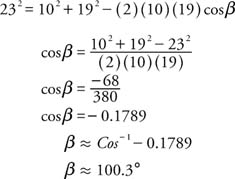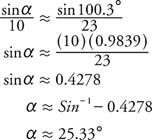
Figure 1
Two cases for SSA.

Figure 2
Ambiguous cases for SSA.

Figure 3
Two cases for SSA.
In Figure 1(a), if b < h, then b cannot reach the other side of the triangle, and no solution is possible. This occurs when b < a sin β.
In Figure 1 (b), if b = h = a sin β, then exactly one right triangle is formed.
In Figure 2 (a), if h < b < a—that is, a sin β < b, < a—then two different solutions exist.
In Figure 2 (b), if b = a, then only one solution exists, and if b = a, then the solution is an isosceles triangle.
If β is an obtuse or right angle, the following two possibilities exist.
In Figure 3 (a), if b > a, then one solution is possible.
In Figure 3 (b), if b ≤ a, then no solutions are possible.
Example 1: (SSS) Find the difference between the largest and smallest angles of a triangle if the lengths of the sides are 10, 19, and 23, as shown in Figure 4 .

Figure 4
Drawing for Example 1.
First, use the Law of Cosines to find the size of the largest angle (β) which is opposite the longest side (23).

Next, use the Law of Sines to find the size of the smallest angle (α), which is opposite the shortest side (10).

Thus, the difference between the largest and smallest angle is

Example 2: (SAS) The legs of an isosceles triangle have a length of 28 and form a 17° angle (Figure 5). What is the length of the third side of the triangle?

Figure 5
Drawing for Example 2.
This is a direct application of the Law of Cosines.

Example 3: (ASA) Find the value of d in Figure 6 .

Figure 6
Drawing for Example 3.
First, calculate the sizes of angles α and β. Then find the value of a using the Law of Sines. Finally, use the definition of the sine to find the value of d.

Finally,

Example 4: (AAS) Find the value of x in Figure 7 .

Figure 7
Drawing for Example 4.
First, calculate the size of angle α. Then use the Law of Sines to calculate the value of x.

Example 5: (SSA) One side of a triangle, of length 20, forms a 42° angle with a second side of the triangle (8). The length of the third side of the triangle is 14. Find the length of the second side.

Figure 8
Drawing for Example 5.
The length of the altitude (h) is calculated first so that the number of solutions (0, 1, or 2) can be determined.

Because 13.38 < 14 < 20, there are two distinct solutions.
Solution 1: Use of the Law of Sines to calculate α.

Use the fact that there are 180° in a triangle to calculate β

Use the Law of Sines to find the value of b.

Solution 2: Use α to find α′, and α′ to find β′

Next, use the Law of Sines to find b′.
